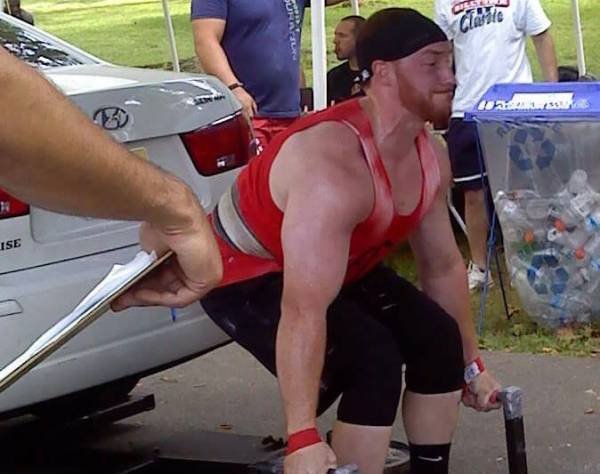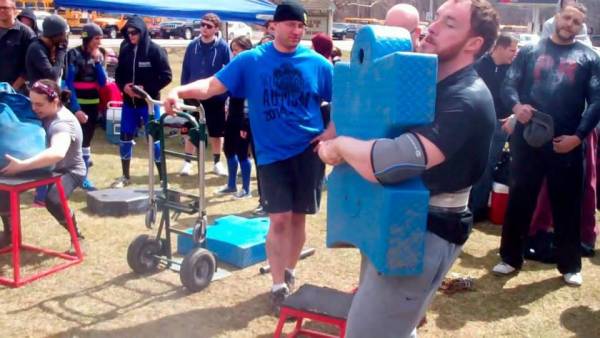I remember watching ESPN’s World’s Strongest Man as a child. As a teenager, I got to see the Arnold Strongman Classic and even met some of the competitors. But it wasn’t until I was a senior in college when I started working at a facility with large tractor tire that I truly got interested in the sport of strongman.
After the thrill I felt from flipping that tire, I decided to try more events. Shortly thereafter, I started competing. I have since competed nine times over the past three and half years. Many of you may be wondering how to get started in this sport, as well. Here are my tips to you.
RELATED: 33 Reasons to Train Strongman
I still get a thrill from flipping tires
1. Get Strong in the Lifts That Matter Most
Overhead Press: I’ve never seen a competition that didn’t start with an overhead press exercise, so it needs to become your top upper-body exercise. Get strong in standing military presses, push presses, and jerks.
To decide if you are overhead press ready, I’ll give you a typical body weight-to-weight pressed scenario. Keep in mind these numbers are lower for the novice class.
- If you compete under 200lbs, you need to be able to press around 200 pounds.
- If you compete in the 200-231 weight class, you will see weights around 230 pounds.
- If you are in the over 231 class, then you are looking at approximately 270 pounds.
These weights can vary depending on the level of competition and/or on the implement used, but these are good roundabout numbers to work toward.
“If you can deadlift 2.25 times your bodyweight, then I say you would have no problem in any deadlift event you will see.”
Deadlift: Out of the nine events in which I competed, eight of them had a deadlift event. In addition, the majority had at least one other event related to the deadlift, such as the farmer’s walk, frame carry, or Atlas stones.
The conventional deadlift is where you will want to spend most of your training time due to the sumo stance being disallowed in strongman. But be sure to get strong in all the different conventional variations. Because most deadlift events are elevated, I think the top variation is the rack pull or block pull. The trap bar deadlift is another variation to rotate into your training because it is just like the pick up in the farmer’s and frame carry.
RELATED: The Sumo Deadlift: Is It For You?
You won’t ever pull sumo in competition, but there’s no need to eliminate the stance from your program. In fact, I program sumo deadlifts regularly because they help build your conventional and they translate well to loading Atlas stones.
If you can deadlift 2.25 times your bodyweight, then I say you would have no problem in any deadlift event you will see. Even if you can’t do that, you may still be able to hang due to most of the events being elevated.

Deadlifting cars beats deadlifting bars
Squat: It’s rare to see a true squat event in a competition, but a strong squat will help every event. The vast majority of my squat training is comprised of the back squat, but the front squat is one of my top assistance exercises.
In events like Atlas stones, clean and presses, and certain carrying events, you will have the load in front of you so it makes a lot of sense to build the front squat. If you can hit a double-bodyweight back squat or are close to that, then your lower body is most likely strong enough to handle any event.
RELATED: The 6 Main Types of Strongman Events (and How to Train For Them)
2. Pick a Competition
There are two amateur strongman organizations in the United States. They are North American Strongman (NAS) and United States Strongman (USS). Every competition I’ve completed has been an NAS-sanctioned event. They were all well run, so I recommend checking them out. USS just started last year and seems to be growing quickly, so be sure to check out their calendar, too.
Once you pick a competition, then you have to pick either the open or novice division. To determine if you need to compete in novice, just look at the competition weights for the open class and ask yourself, “Will I be able to do at least three or four of the five event weights?” If your answer is “no,” then novice is the better choice until you get stronger.
Just don’t be that guy who clearly should be in the open class but instead opted to dominate the novice class. Not scoring in one event isn’t the end of the world and it happens often to everyone, so if you can handle four of the events, then go open.
“[A]sk yourself, ‘Will I be able to do at least three or four of the five event weights?’ If your answer is “no,” then novice is the better choice until you get stronger.”
For your first outing, try to pick a competition that you have access to all the equipment needed to train for the events. Your first competition will be nerve-racking enough without worrying about an event you’ve never actually experienced.
In addition, pick a competition you have enough time to prepare for. Pick an event at least twelve weeks away in order to give yourself ample time. Since it is your first competition, you will need a lot of time learning and training the specific events you will face. Once you have learned most of the events and have a strong foundation, you will not need that long to prepare for future competitions.

Make sure you get to practice the events before game day
3. Find a Partner and Make a Plan
Having a partner or crew to push you and coach you is vital for your success. I’ve been fortunate to have my best friend join me in this strongman journey, and I probably wouldn’t have had the same success without him. (And by the way, your training partner also comes in handy for splitting expenses on training equipment or travel to a competition.)
Aimlessly lifting works for beginners, but if you’re reading this, then you are most likely not a beginner to some sort of strength training. There are a lot of programs out there to help prepare you. To prepare for competitions I have used 5/3/1 and a modified Cube method. Currently, I am using Triphasic Training.
Whatever you do, whether it’s creating your own program or following someone else’s, make sure it is big on the lifts that matter, is specific to the competition you are training for, and has a focus on your personal weaknesses.
“Try and stay within five pounds of your weight class all year round, so you can train near competition weight and not have to cut calories right before the big day.”
Also worth noting: make a nutrition plan if you need to lose or gain weight. Gaining weight shouldn’t be hard but cutting weight for strongman can be risky, especially if you wait too long to cut.
I made that mistake last year. I didn’t plan out my nutrition and found myself only six days out from competition and twelve pounds overweight. In order to make weight, I had to dehydrate myself and fast the day before the event, which hurt my strength levels immensely. Try and stay within five pounds of your weight class all year round, so you can train near competition weight and not have to cut calories right before the big day.

Glad I packed the elbow sleeves
4. What to Do on Game Day
You’ve prepared, you’ve trained, and all the work has been done. Now make sure you arrive with the essentials to go out and kill some weights. Below is a list of things you need to bring to the competition:
- Lifting equipment: belt, straps, wraps, chalk, foam roller, or anything else you use when you lift.
- Lots of food: I did a competition that lasted eight hours, so pack more food than you think you need. Pack food you’re used to and that is easy on the stomach.
- Cooler: filled with ice, drinks, and your food.
- Chair: gotta be comfortable during downtime.
- Good toilet paper or baby wipes: nature seems to always call at competitions and you don’t want the single ply in that porta-potty.
- Weather gear: leave it to the ginger to remind you to pack that SPF 50 if it is summer or warm clothes if winter
- Pre-workout: Sip it all day
- Atlas Stone materials: tack, baby oil, and a change of clothes you don’t mind ruining with tack. Bring a tight shirt and shorts when doing stones so the stone doesn’t pull your shirt with it. Don’t bother taping your forearms – man up and go bare skin.
- Change of clothes: for during the competition if you sweat a lot, possibly for an Atlas stone event, and definitely for celebrating after.
- Camera: So you can review your performance and for memories.
Show up an hour and a half before the rules meeting. This will give you time to set up camp, warm up, and try out the implements. Aside from that, the best advice I can give is to have fun and learn from your own performance and from other competitors.
RELATED: Life of a Strongman: An Interview With Tom McClure
Strongmen Are Friendly
Strongman competitors can look mean, but I assure you they are some of the friendliest humans on planet earth. So don’t be surprised when your competition is cheering you on and giving you tips. Don’t be afraid to ask questions or to shoot the shit with some of the more experienced competitors.
I hope this article has given you some insight on beginning your strongman career. If you have any questions feel free to comment below and I will be more then happy to help.






